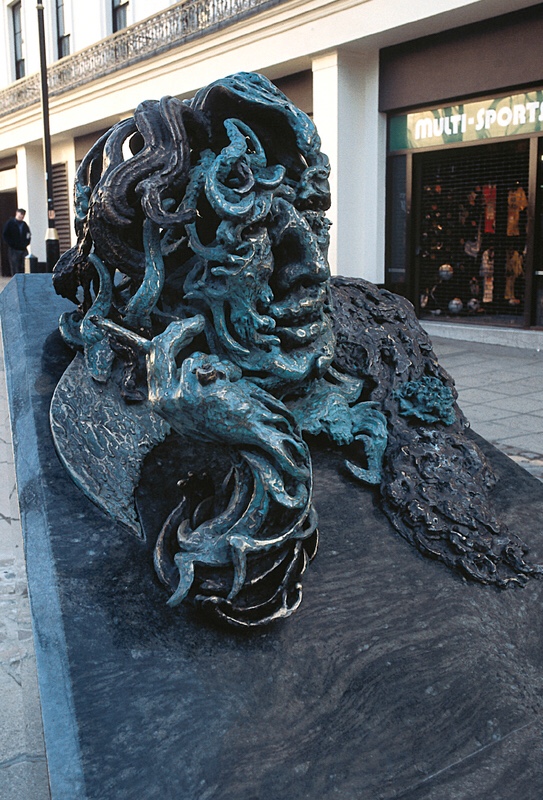A captivating series of exchanges between famous artists and their associates, reveals fascinating glimpses into their private and professional lives in a new, free display at the Paul Mellon Centre for Studies in British Art.
Opening today (Monday 1 October 2018) and running through to 14 January 2019, Artist’s Letters features correspondence between the legendary art critic Brian Sewell and Maggi Hambling, art dealers M. Knoedler & Co and Augustus John, plus art historian Lionel Benedict Nicolson’s communications with fellow undergraduate and housemate, Jeremy Hutchinson regarding the formation of an arts society at Oxford University.
The intimate display focuses on the twists and turns of the relationship between Sewell and Maggi Hambling; the history and provenance of a little-known painting by Augustus John, and the establishment of the Florentine Club in the 1930s using fragments of correspondence, newspaper pages, notes and diaries discovered in the archives of Sewell, Nicolson and Simpson.

Brian Sewell developed what may have seemed at first an unlikely friendship with the renowned artist Maggi Hambling after an absolute zinger of a review of her sculptural tribute to Oscar Wilde. Writing in the Evening Standard in 1997, the critic was scathing about the piece, declaring it to be the product of an artist who was a “barely competent draughtsman” and a sculpture that betrayed “not the slightest talent, intelligence or skill”.
However, a decade earlier, Hambling had written to Sewell inviting him to her exhibition Maggi Hambling: Paintings, Drawing and Watercolours at London’s Serpentine Gallery. She wrote soon after the Gallery had weathered the Great Storm of that year, and her letter semi-jokingly refers to the fact that “the Serpentine stands undamag ed in the midst of terrible destruction”. Like other letters found in Sewell’s archive, this handwritten invitation demonstrates the keenness of artists to attract his attention, and to generate what they hoped might be approving reviews of their work.
Renowned for his damning critiques, Brian didn’t spare an artist’s feelings if he thought their work was poor but Maggi reveals herself to be a resilient character. She wrote: “I would never condemn anyone who made me laugh”; and responding to Sewell’s critique of her Wilde sculpture, she noted that it “had been served a feast of the best possible street cred”.
The pair further bonded over a mutual love of dogs and hatred of Woolworths picture frames, setting in motion a seemingly improbable friendship that would last until the end of Sewell’s life. Indeed, writing an obituary for the Observer in 2015, Hambling said of her late friend: “His surviving dogs are not alone in lamenting their often misunderstood, but never boring, fellow creature”.

The sale of Augustus John’s La Belle Jardinière (The Beautiful Gardener) in 1944 prompted the art dealers, M. Knoedler & Co to write to John himself asking for information about the work, which was a portrait of the artist’s muse and second wife, Dorelia.
The firm had previously asked John to sign the work and now asked for his advice on varnishing, details of the painting’s exhibition history, the location in which the picture was painted, and for details of the date it was completed. The last question was one that they seem to have asked twice of the artist, for at one point they note, in a rather irritated tone, “how could one ask him the same thing again [?]”
From his short reply John makes clear that the location of the painting was not Hanley, “wherever that is”, but was in fact Alderney Manor, the former home he shared with Dorelia. He also states that the painting was “never publicly exhibited” and was acquired by Sir James Dunn. John also confirms to Knoedler & Co that the subject is indeed his wife Dorelia, noting her “dark beauty” and the “free flowing dress” that is evident in the painting.
The correspondence provides a valuable insight into the mechanisms of the art market and understanding of the relationship between dealer and artist.

Benedict Nicolson became the distinguished editor of The Burlington Magazine and prior to his career in publishing and the press, he was already passionate about the arts. In Artist’s Letters, we can enjoy his personal endeavours, along with his friends, to create an arts society whilst up at Oxford.
Artist’s Letters is free to view from Monday – Friday, 10am-5pm at the Centre. For more information please see https://www.paul-mellon-centre.ac.uk/whats-on/forthcoming/artistsletters



